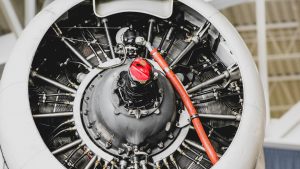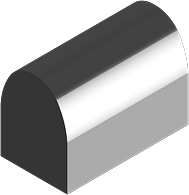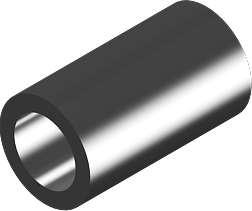Steel 17-22A(S)
View AMS Numbers >
Steel 17-22A(S)
Steel 17-22A(S) is structural low alloy steel with high levels of Carbon, Chromium, Molybdenum, Manganese, Silicon, and Vanadium. It is a version of Steel 17-22A, but with higher Chromium content, which gives it slightly higher hardenability and corrosion resistance. Steel 17-22A(S) also possesses excellent machinability and toughness.
Steel 17-22A(S) has several properties that make it an excellent choice for parts that are exposed to higher temperatures for short periods and parts that require strength at higher temperatures. Other properties of Steel 17-22A(S) include ultra-high-strength at room temperature and high heat resistance.
Due to the qualities it possesses, Steel 17-22A(S) is primarily used for manufacturing shafts, studs, and fasteners, mechanical parts in aviation, mechanical parts in engines, steam turbines, industrial furnaces, guided missiles, turbine rotors, and petrochemical engineering operations.
According to some findings in “Symposium on Strength and Ductility of Metals at Elevated Temperatures”, Steel 17-22A(S) is superior to ferritic stainless steels at temperatures below 1100°F (593°C) when it comes to unnotched rupture strength, but offers lesser performance at temperatures higher than 1100°F (593°C).
Tech Steel & Materials offers Steel 17-22A(S) in 3-sub-type specifications and multiple shapes/forms:
Chemical Composition
| Element | min | max |
| Carbon | 0.28 | 0.33 |
| Manganese | 0.40 | 0.70 |
| Silicon | — | 0.65 |
| Phosphorus | — | 0.025 |
| Sulfur | — | 0.025 |
| Chromium | 0.80 | 1.25 |
| Molybdenum | — | 0.50 |
| Vanadium | 0.25 | 0.35 |
| Nickel | — | 0.25 |
| Copper | — | 0.35 |
| Iron | Balance* | — |
*Not exclusively to the element mentioned, but that one predominates other elements that are used only in minimal quantities.
Fabrication and Working Instructions
The Steel 17-22A(S) has a 1000-hour rupture strength at 1100°F (593°C) of 30,000 psi, which makes it an excellent choice for high-temperature applications. However, some independent tests show that the Steel 17-22A(S) is notch-sensitive at rupture times over 100 hours, with severe cracking at higher temperatures. That’s why it is highly recommended parts made of Steel 17-22A(S) to be designed without sharp notches, which will somewhat reduce the chance of cracking to occur. This is especially important for parts that will be used in highly-stressed equipment exposed to higher temperatures.
Like other low alloy steels, Steel 17-22A(S) can be welded using all traditional welding methods, including arc welding and gas welding. For best results, the use of the Steel 17-22A(S) welding wire is recommended, which has the AMS 6458 designation. Before welding, it is recommended that the parts are preheated to 600°F (315°C), followed by stress relief or post-heating.
Heat Treatment
Tempering the Steel 17-22A(S) at any temperature up to 1100°F (593°C) increases the hardness of the as normalized material. The usual heat treatment for 1-inch diameter parts is:
- Normalizing – heat the material to 1700-1850°F (926-1010°C) and hold at that temperature for one hour for each inch of thickness. Then the air-cool technique is recommended, with fan-cooling for larger sections in order to accelerate the cooling process. All surfaces of the part must have access to air when cooling.
- Annealing – heat the material to 1450°F (787°C) for and hold at that temperature for one hour for each inch of thickness. Cool for 17.5 hours (20°F or 11°C per hour) to get to 1100°F (593°C).
- In case of oil quenching, heat the material to 1750°F (955°C) first for each inch of thickness.
Mechanical Properties
| Tensile strength | 231 | σb/MPa |
| Yield Strength | 154 | σ 0.2 ≥ /MPa |
| Elongation | 56 | δ5 ≥ (%) |
| ψ | — | ψ ≥ (%) |
| Akv | — | Akv ≥ /J |
| Reduction in cross section on fracture | 14 | % |
| Impact Strength | 30 | KV/Ku (J) |
| Brinell Hardness | 442 | HBW |
Thermal Properties
| Temperature | 105°F (41°C) | 307.5°F (153°C) | 889°F (476°C) |
| Modulus of elasticity (GPa) | — | — | 294 |
| Mean coefficient of thermal expansion 10-6/(°C) | — | 21 | — |
| Thermal conductivity (W/m·°C) | — | 13.2 | 22.3 |
| Specific thermal capacity (J/kg·°C) | — | — | 213 |
| Specific electrical resistivity (Ω mm²/m) | 0.21 | — | — |
| Density (kg/dm³) | — | 211 | — |
| Poisson’s coefficient | — | 441 | — |
Select AMS Number:
| AMS Number | Alloy | Type | UNS | Cross Ref. Spec | Misc./Shape | |
|---|---|---|---|---|---|---|
| AMS 6302 Bar | 17-22A(S) | Steel | K23015 | - | Bar |
 |
| AMS 6302 Forging | 17-22A(S) | Steel | K23015 | - | Forging |
 |
| AMS 6302 Tubing | 17-22A(S) | Steel | K23015 | - | Tubing |
 |
| AMS 6385 Plate | 17-22A(S) | Steel | K23015 | - | Plate |
 |
| AMS 6385 Sheet | 17-22A(S) | Steel | K23015 | - | Sheet |
 |
| AMS 6385 Strip | 17-22A(S) | Steel | K23015 | - | Strip |
 |
| AMS 6458 |
17-22A(S) | Steel | K23015 | - | Wire |
 |

 Tech Steel & Materials
Tech Steel & Materials